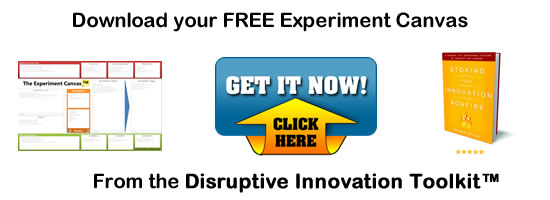Why Hesitate? Innovate. Start, and Learn.
 Often there is so much anxiety about innovation. Is it just a fad, or is it a viable, potent form of value generation?
Often there is so much anxiety about innovation. Is it just a fad, or is it a viable, potent form of value generation?
Is it something that needs to be outsourced, set up as a skunk works, or can I add it to the existing responsibilities of our employees?
Other companies are out-innovating us. The world has changed. Our market has changed. We claim that innovation is one of our core principles, a pillar, but the only program we tried was an idea-generation submission and it bloated our new product development pipeline.
We hear similar words in the echo chamber and water coolers of most corporate conversations of companies who have not yet figured out how to have a formal innovation program in their culture.
Getting started is the hardest part. So much time gets lost trying to predict the outcome before beginning the work – and with this type of work, front-end market exploration, predictions will not be accurate until you are knee-deep inside the process of a real project. Fretting at the starting line will not accelerate growth.
Innovation is not a linear, analytic process where a business case is built, investments made and products launched. Rather, it is a recursive, iterate framework for spending small increments of time and money to learn more and design a solution for a real problem.
The good news is that you can manage the budget carefully and get a staggering return on investment. The bad news is you have to adapt to a new work mode – and this point is where people get paralyzed before the work even starts.
Every possible excuse gets thrown up as a smokescreen from trying something new.
We need to fix our new-product development process first. We need to reorganize our sales organization first. We need to fix a few things in the culture first. We need to (fill in the blank with today’s diversion).
Allow me to say that doing the front-end innovation work itself is curative, revealing so much about a company. You’ll learn so much about the market, your team, your organizational structure and, most important, where to place and not place bets on growth.
You’ll also figure out who are the team players, the big thinkers and the equally valuable detail doers. You’ll stumble into unconscious defaults, blind spots, biases and obstacles inherent in the system of the organization. You’ll learn deeply, but you have to start the process to earn these boons.
Admittedly, there is a driving bias toward action. Action stimulates. Action learns on its feet. Action engages people. Action connects companies with their customers in deep, meaningful ways. Action wins in a competitive marketplace. Action is contagious. Action helps retain high performers.
So, why are you reading this piece? To be active and learn how to generate value that grows? Why hesitate? Innovate now. It’s inexpensive to begin and might catalyze your organization for generations to come, but, as a sign reads in Las Vegas, “You must play to win.â€
Wait! Before you go…
Choose how you want the latest innovation content delivered to you:
- Daily — RSS Feed — Email — Twitter — Facebook — Linkedin Today
- Weekly — Email Newsletter — Free Magazine — Linkedin Group
 Michael Graber is the managing partner of the Southern Growth Studio, an innovation and strategic growth firm based in Memphis, TN and the author of Going Electric. Visit www.southerngrowthstudio.com to learn more and follow @SouthernGrowth
Michael Graber is the managing partner of the Southern Growth Studio, an innovation and strategic growth firm based in Memphis, TN and the author of Going Electric. Visit www.southerngrowthstudio.com to learn more and follow @SouthernGrowth
NEVER MISS ANOTHER NEWSLETTER!
LATEST BLOGS
Three things you didn’t know about credit cards
Photo by Ales Nesetril on Unsplash Many of us use credit cards regularly. From using them for everyday purchases to…
Read MoreFive CV skills of a business-minded individual
Photo by Scott Graham on Unsplash The skills listed on a CV help employers quickly understand your suitability for a…
Read More


